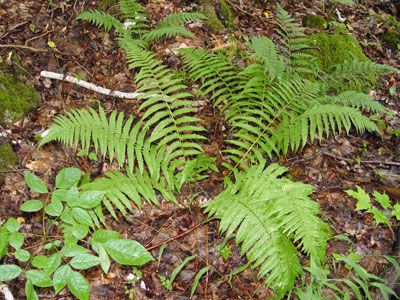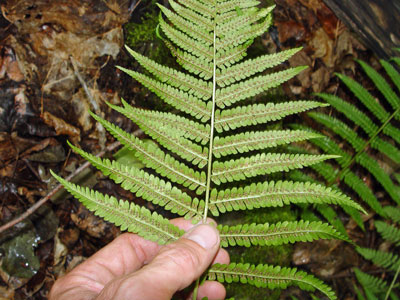DACF Home → Bureaus & Programs → Maine Natural Areas Program → Communities, Plants, and Animals → Rare Plants → Dryopteris filix-mas

Dryopteris filix-mas (L.) Schott ssp. brittonii Fras.-Jenk. & Widen
Male Wood Fern
- State Rank: S1
- Global Rank: G5T4?
- State Status: Endangered
Habitat: Rich woods, glades, upland pastures and rocky slopes (chiefly limestone, trap or slate). [Hardwood to mixed forest (forest, upland)]
Range: Newfoundland and Labrador to Alaska, south to Vermont, northern Michigan, South Dakota, Arizona and California.
Aids to Identification: The male fern is closely related to, and may be found with, our common marginal shield fern (Dryopteris marginalis) but can be distinguished from that species by its often larger size, its rich green color (compared to the bluish or grayish green of the marginal shield fern),its relatively short petiole (up to 1/4 the length of the blade), and its prominent sori (clusters of sporangia, on the back of the frond) which are closer to the middle of the leaf segment, not right at its edges as are those of D. marginalis.

Ecological characteristics: Known in Maine from calcareous ledges and talus slopes.
Phenology: Sori are large and prominent. They are nearer the midvein than the margin.
Family: Polypodiaceae
Synonyms: Polypodium filix-mas L.
Known Distribution in Maine: This rare plant has been documented from a total of 3 town(s) in the following county(ies): Oxford, Penobscot.
Reason(s) for rarity: According to some authors, rare throughout its United States range. Because of its rarity and attractiveness, the male fern has been dug up from some of its former stations by collectors and is now declining in much of its Americann range.
Conservation considerations: Effects of logging are unknown, but partial removal of the canopy would be less likely to adversely affect the plant than complete removal. Known populations are small and localized.